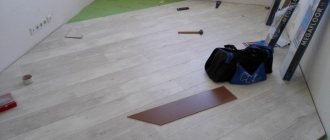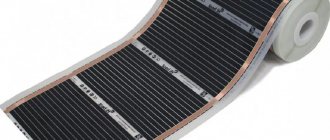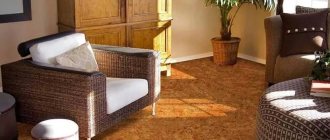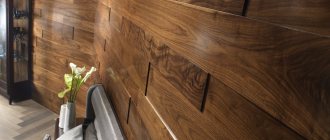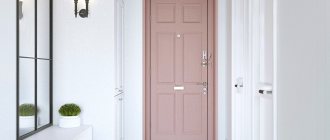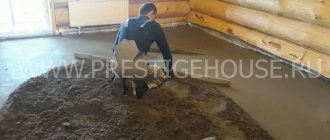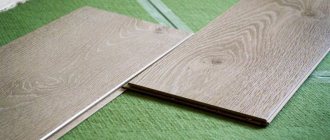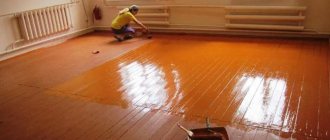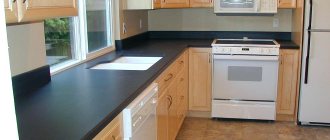Replacing the floor is a headache for the owners, financially burdensome and troublesome. When choosing what to buy, parquet, laminate or linoleum, they always look at how much it costs, how long it lasts and how difficult it is to care for. Parquet flooring immediately falls out of this row - the current prices for the material are beyond the means of the middle class. The indicators of the two remaining types - laminate and linoleum - are often very close to each other. As a result, a dilemma arises: what is better to choose - linoleum or laminate for your apartment or house. In order not to become “Buridan’s donkey”, who died without deciding which armful of hay, left or right, to eat, let’s compare floor coverings and find out which would be best to stop at.
Linoleum and laminate panels.
Laminate
Many people consider laminate flooring to be a natural floor covering due to the wood fibers present in its composition. This statement can be questioned, since the cellulose fibers are held together by a polymer-based resin. When creating laminate, manufacturers use pressed hardboard slabs. The material acquires a multilayer structure. The base has an additional protective coating on both sides. This function is performed by kraft paper with additional impregnation with phenol or an applied polymer coating. On the front side, acrylic material or melamine resin is sprayed onto the surface, partially preventing the penetration of moisture into the thickness of the material. Laminate does not withstand direct contact with water, but can be easily cleaned with a damp cloth. Special spraying provides additional protection against mechanical deformation.
To answer the question of what is better to lay on the floor: laminate or high-quality linoleum, you need to familiarize yourself with the characteristics of the specific room for laying the linens. Thus, in the kitchen there is a high level of humidity, so laying laminate flooring in such a room cannot be considered the best solution.
The surface protective layer can take on different thicknesses. It determines whether the laminate belongs to a particular strength class. The most stable laminate cannot boast a protective coating thickness exceeding 1mm.
Laminate belongs to the category of block-type floor coverings, which fundamentally distinguishes it from any type of linoleum. During the installation process, small “planks” are to be laid.
The most widely used laminate flooring has wedge latches on all sides. This coating greatly facilitates the installation process, but there are minimal gaps between the blocks. Some experts consider this feature to be a disadvantage of the solution, since moisture can concentrate in the gaps.
Laminate with wedge latches allows you to avoid rigid adhesion of each sheet to the floor plane. When the temperature changes, the canvases do not deform. Adhesive-type laminate is much less common, since its installation is extremely difficult for the master. The canvases are rigidly fastened to the floor plane, and therefore the risk of deformation increases with a sharp change in the thermal conditions in the room. When properly installed, the gaps between adjacent laminate slabs become waterproof. There is also a tongue-and-groove laminate, which is very rare on the modern market. It has a characteristic relief at the ends.
Laminate has a major disadvantage: it is susceptible to moisture. Regardless of whether they belong to one class or another, coatings are not able to withstand the penetration of water into their thickness. As a result of such processes, deformation of the material occurs without the possibility of subsequent recovery. Only damaged elements can be replaced. If the boards are “set” with glue, they will have to be cut out. With wedge-type laminate, it is enough to dismantle the damaged boards and replace them with new ones.
Tile installation methods
Vinyl tiles may vary in installation method. Tiles with a locking type of connection are assembled according to the laminate principle. This is a really simple installation method, but such tiles can only be installed on the floor. In addition, this type of tile is less protected from moisture - if a large amount of water spills, it can seep into the cracks near the walls (which must be left to allow the tile to expand in the event of a temperature change).
Adhesive type tiles are more versatile - they can be installed on walls as an interesting design element, they fit tightly to the floor and do not allow water to pass through. However, laying such tiles will take more time. In order not to apply glue yourself, you can purchase tiles with a self-adhesive base - this is a good way to make installation work easier.
Laminate classes
Whether a laminate belongs to one class or another determines the thickness of the top protective layer and the strength parameter of the products.
Class 31 remains the least resistant to external influences. It is intended for use with low intensity: in bedrooms, dressing rooms, pantries. The service life does not exceed 12 years.
Belonging to class 32 laminate allows it to be used in rooms with higher traffic: living rooms, living rooms. Its average service life is limited to 15 years. It is not advisable to use such a solution in commercial premises, since here it will last much less.
Class 33 laminate is considered commercial. Within its category, it remains the least durable. Laminate is widely used in the design of gyms, living rooms, hallways, and children's rooms.
The maximum strength class of laminate is considered to be class 34. Belonging to this category, laminate can withstand significant loads, therefore it is actively used in the arrangement of premises in shopping centers and dance floors. Its service life at home is more than 30 years.
You can get acquainted with the collections of class 33 and 34 laminate in the catalog of our online store:
- 33rd grade
- 34th grade.
Cork floor
Another natural covering that many people unfairly ignore is cork board. This material looks very presentable, it absorbs sound perfectly, is warm and pleasant to the touch, safe, resistant to moisture, so it is used even in unheated rooms, in the kitchen and bathroom. Its few disadvantages include susceptibility to mechanical damage. It is better not to walk on such a floor in stiletto heels and not to place heavy furniture on wheels on it. Cork flooring is not much cheaper than the same parquet, but its installation is not very expensive, so it is a completely affordable alternative to laminate. It is especially good to cover floors with it in houses where children live.
Decorative design
In appearance, laminate is as close as possible to natural wood. Varieties of laminate organically fit into any interior style and look very attractive in appearance. In addition to classic variations, modern manufacturers offer original solutions with imitation of natural wood: natural coating (with a thin varnish layer that brings the appearance of the laminate as close as possible to natural wood), glossy models (with imitation of varnished wood), matte (visually reminiscent of oiled natural parquet), aged coatings, textured models (reminiscent of rough-hewn boards), waxed solutions (boards with a warm and soft shine, reminiscent of waxed floors). Often, decorative designs are additionally applied to laminated boards.
Modern technologies make it possible to produce completely non-standard laminate. For example, imitating leather or stone.
Chipboard
Particle boards are considered by many to be an exclusively rough material, unsuitable for finishing. However, some craftsmen manage to use them for laying floors. Surfaces for which the craftsman uses materials of different shades, laying out the boards in a pattern (herringbone, checkerboard or zigzag) look especially original. This type of coating also includes laminated chipboard “Nevsky Laminate”. Are these slabs an alternative to more traditional flooring? Of course, because they have excellent quality characteristics: they are made from natural wood shavings, they are durable, they can be trimmed, drilled and glued. The slabs come in different thicknesses - from 8 to 22 mm. In addition, the manufacturer offers several dozen different shades of slabs, including quite unusual ones - “Aluminium”, “Anthracite”, multi-color “NewPort”.
Linoleum
Linoleum belongs to the category of rolled floor coverings with its characteristic moisture resistance and moisture resistance. The material is absolutely not afraid of wet cleaning with or without detergents. Provided that the installation technology is strictly followed, the laminate can retain a small amount of liquid and prevent leakage. When choosing which is better - laminate or linoleum, the expert’s opinion will be based on the combination of product characteristics and room features.
Floor board
Floorboards are what people have walked on for several thousand years. However, recently this flooring has been unfairly forgotten, although it is a wonderful alternative to laminate and parquet, because it has many advantages:
- low cost;
- ease of installation;
- practicality of operation;
- durability (will last several decades).
But for all these benefits to really pay off, the floorboards must be made from high-quality hardwood lumber.
Materials used
The characteristics of linoleum are largely determined by its belonging to one type or another. Natural material has fundamental differences from other solutions in terms of composition, characteristics and price. Manufacturers classify it as a separate category of floor coverings and give it the name marmoleum.
Marmoleum has a jute base on which layers of wood flour and chalk are applied. Resins and oxidized linseed oil act as a connecting link between them. Appropriate natural dyes are used to apply the design. Marmoleum cannot compete with other types of coating due to its high cost.
Nitrocellulose-based linoleum is more common. Among its advantages are increased ductility, low thickness and high strength. Linoleum has a high tendency to burn, so it is not recommended for interior decoration.
Linoleum made of a special plastic - griftal - has a fabric base. Its distinctive features are considered to be high heat and sound insulation characteristics. With prolonged use, linoleum experiences deformation. It stretches out in width and becomes shorter in length.
Rubber linoleum is the undoubted leader in terms of elasticity and resistance to moisture. This allows you to lay the canvas on a base with minor unevenness without much difficulty. Toxicity prevents the use of this material in residential areas.
PVC-based linoleum is actively used in homes and offices. It can be completely devoid of a base or produced on a special backing made of fabric, felt or foamed PVC.
Parquet
The first thing that comes to mind is parquet and parquet boards. These are natural materials made from solid wood of different types. They differ in size from each other. Parquet is small planks, and parquet boards look like laminate. The environmental friendliness and safety of this type of flooring are its main advantages. Modern parquet samples are distinguished by good strength, moisture resistance and durability.
However, low-quality material can shrink and deform, and partial replacement of panels is sometimes impossible. At the same time, it is quite expensive, in addition, laying parquet is also not a cheap pleasure. The total cost of one square meter of such coverage (material and installation) starts from 2 thousand rubles, and there is no upper limit at all. Parquet is a good alternative to laminate, but not the last one on our list.
Types of linoleum
Whether linoleum belongs to one class or another determines its strength characteristics, wear resistance and other parameters.
Household linoleum remains the most budget-friendly solution. Most often it is represented by a multilayer material based on foamed PVC. Additionally, linoleum contains a decorative layer and a special protective coating. The total thickness of the layers rarely exceeds 4 mm. The linoleum base is quite soft and has a short service life.
Semi-commercial linoleum is an improved prototype of household linoleum. Its strength characteristics are higher, and its thickness reaches 7mm.
Commercial type linoleum is designed for high traffic areas and has maximum wear resistance. For most models, the surface has an additional anti-slip coating to prevent injuries during operation. The question of what is better to lay: laminate or linoleum is decided for a specific room.
Specialized linoleum is manufactured according to the specific requirements of the room. There are sports coatings with a polyurethane base, medical linoleums with a bactericidal surface layer. No less popular are solutions for music studios with increased sound insulation. The surface of the material can be embossed to prevent slipping even on a wet surface.
Wood
Another environmentally friendly option, which is often used in private homes, country cottages, tourist areas and other similar premises. Currently, this material is increasingly used in housing construction, since it has significant advantages. It is not afraid of fluctuations in moisture levels, temperature changes and constant loads. Depending on the type of wood, the strength of the coating can vary significantly. Most often, regular pine is used, but other wood options are also found.
Wooden floor Source chudopol.ru
Insulating properties
Sound and heat insulation largely depends on the substrate material used and its thickness. The use of a backing for linoleum is an additional measure; for a laminate, the presence of a backing is a prerequisite. The warmest is linoleum with a fabric or felt base. The felt base promotes more effective sound absorption. If you move across the laminate in hard shoes or heels, then the sounds, on the contrary, will spread throughout the apartment. The problem can be partially solved by using a high-quality substrate.
Carpeting
This material is soft, quite warm and, of course, silent. It differs from laminate in that it is a real dust collector. Cleaning such a coating takes a lot of time, as opposed to other material, which just needs to be wiped with a damp cloth.
If a dye accidentally gets on the carpet, cleaning will be very difficult, one might even say impossible. In places where people walk the most, a well-trodden path forms, which does not look very attractive. In winter, especially in bedrooms, if there are no heated floors, it provides more comfort and coziness than its opponent, laminate.
Laying and repair
Both coatings are characterized by ease of installation and strict requirements for compliance with existing installation technology. The installation of laminate flooring requires a more responsible approach. Linoleum is much easier to lay and this procedure takes less time. Laminate is installed on a perfectly flat surface, while linoleum is less demanding. Laminate is considered more repairable. If necessary, deformed boards can be replaced. Damaged linoleum will have to be completely replaced.
Video description
Review of the best floor coverings.
Boards come in different shapes and sizes, which allows you to choose a product for each specific room, taking into account its characteristics. In spacious rooms, long planks would be appropriate, and in small rooms, short ones. Such combinations will help adjust the dimensions of your home and give it a more comfortable look. Modern technologies include a new type of fastening, thanks to which it is possible to reduce the gaps between boards.
Compared to parquet, installation of wooden floors is much faster. Wood is suitable for many interiors, but its disadvantage is the lack of variety of colors and shades, as well as the likelihood of drying out over time. The high price and difficulty of repair are the main differences between the product and laminate.
What indicators affect the environmental friendliness of raw materials?
The main indicators that affect the environmental friendliness of raw materials are the manufacturing method and composition. We analyzed them in detail. But there are some other indicators that affect this characteristic. These include:
- the ability to cause an allergic reaction;
- complexity and type of disposal.
In everyday understanding, environmental friendliness is determined by the impact on human health. Globally, recycling is of great importance, as it affects the environment as a whole, and, consequently, human health outside the home.
Porcelain tiles
This coating has gained popularity due to its strength, resistance to mechanical and chemical influences, temperature fluctuations, as well as humidity and constant loads. The properties of the material allow it to be used both inside and outside the building. Porcelain stoneware does not contain harmful impurities, does not cause allergies and does not react with other substances. This product retains heat perfectly and is often used in combination with electric heating systems for private houses and apartments.
Living room with porcelain stoneware Source zonapola.ru
To install porcelain stoneware, use a carefully leveled base. The material is fixed with glue, the tile seams are sealed with a suitable matching grout. The result is a smooth and stable surface.
On sale you can find different versions of porcelain tiles, which differ in their texture and appearance. The most common are:
- Polished;
- Semi-polished;
- Glazed;
- Matte.
New series of products appear from year to year, so the choice of products is quite wide. When purchasing, it is important to take into account the style of the interior, for which a suitable texture solution is selected. Here you can show your imagination, there are practically no restrictions. The only important caveat is that you should not use polished slabs in bathrooms and other wet rooms, otherwise there is a risk of injury. Once chosen and correctly laid, porcelain stoneware will serve its owners for years without losing its original properties.
